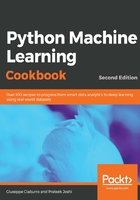
上QQ阅读APP看书,第一时间看更新
Getting ready
In hierarchical clustering, we construct clusters by partitioning the instances recursively using a top-down or bottom-up fashion. We can divide these methods as follows:
- Agglomerative algorithm (bottom-up): Here, we obtain the solution from individual statistical units. At each iteration, we aggregate the most closely-related statistical units and the procedure ends when a single cluster is formed.
- Divisive algorithm (top-down): Here, all units are in the same class and the unit that is not similar to others is added to a new cluster for each subsequent iteration.
Both methods result in a dendrogram. This represents a nested group of objects, and the similarity levels at which the groups change. By cutting the dendrogram at the desired similarity level, we can get a clustering of data objects. The merging or division of clusters is performed using a similarity measure, which optimizes a criterion.